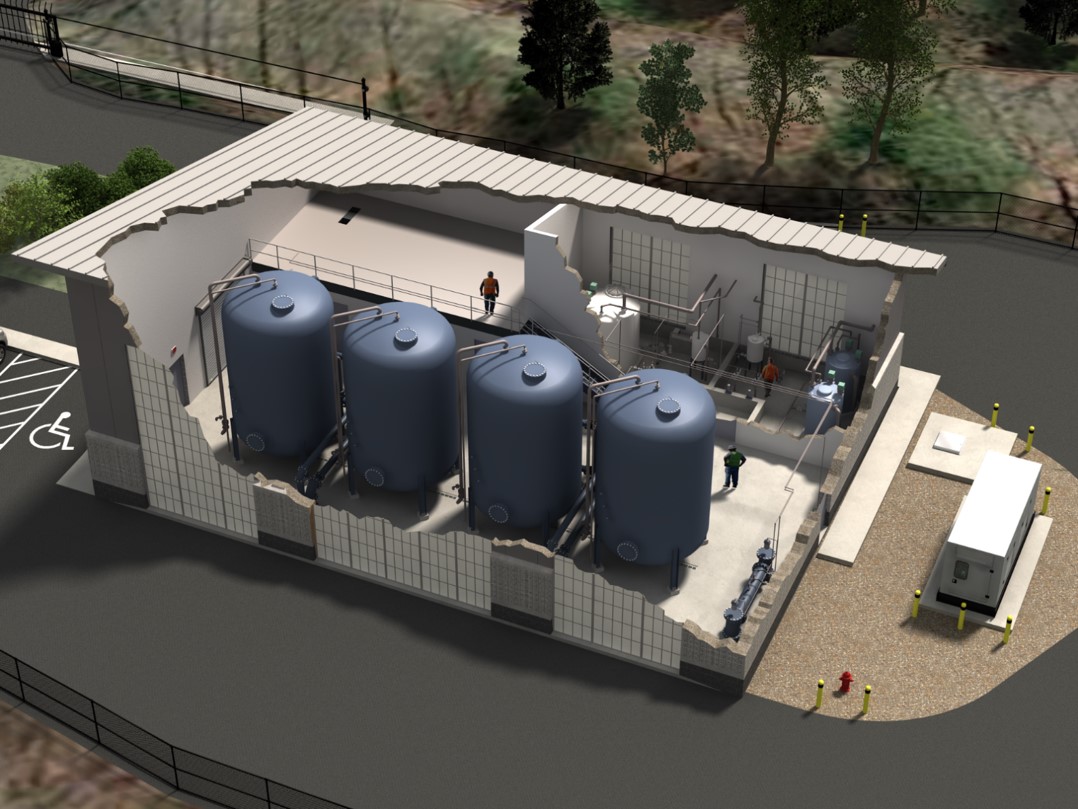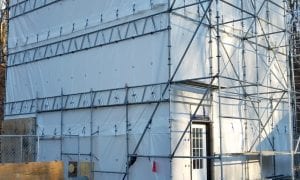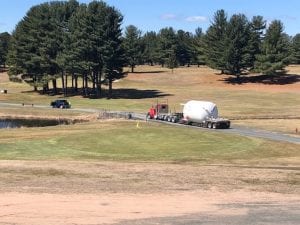
One of the four vessels of the water treatment plant is being brought to the Owens District Road site. (Photo courtesy Westfield Water Dept.)
by David Billips, Director of Public Works for the City of Westfield
With new proposed regulations coming out from the Massachusetts Department of Environmental Protection (MassDEP) Bureau of Waste Site Cleanup this week, the Department of Public Works – Water Division is pleased to announce that Westfield is well prepared to meet and exceed these standards. Because of forward-thinking decision-making, these proposed regulations will not change the way that the DPW operates the water system or the plans moving forward. The standard that the DPW has committed to, non-detect, has been met by the temporary treatment at well 2, and will be the standard for the permanent treatment plant under construction at wells 7 & 8, which is on time and expected to begin supplying water this summer.
In 2013 the Environmental Protection Agency (EPA) identified contaminants of concern, that being the family of perfluorinated carbons. The EPA issued a health advisory of 600 parts per trillion (ppt) for two of these compounds, PFOS and PFOA. All Westfield drinking water sources were under the advisory levels. In late 2015 the Water Division of the Department of Public Works (DPW) became aware a new health advisory was imminent. Out of an abundance of caution, and before said advisory was issued, the department ceased use of wells 7 & 8. Test results for these sources were substantially higher than levels in wells 1 & 2. The DPW proactively began addressing the issue by investigating alternatives, including carbon filtration on impacted wells.
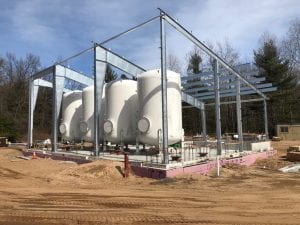
The water treatment plant on Owens District Road begins to take shape. (Photo courtesy Westfield Water Dept.)
In May of 2016 EPA did indeed update the advisory with new levels of 70 ppt. In February 2018 the department was notified the advisory was changing to include five long chain compounds as opposed to the two originally identified. The three additional compounds were PFNA, PFHxS and PFHpA. Again, the department reacted immediately and removed well 2 from service.
Temporary treatment was aggressively pursued for well 2 and the system became functional in late 2018. Well 1 was removed from service and the temporary system at well 2 is the exclusive source for the majority of water on the North Side of the city. Samples are taken well ahead of the DEP recommended schedule and have shown non-detect at both the granular activated carbon (GAC) vessel midpoint and point-of-entry to the system.
On April 19, 2019 the MassDEP Waste Site Cleanup Program will issue draft regulations under 310 CMR 40.0000 establishing reportable concentrations and cleanup standards for six PFAS compounds of 20 ppt in combined groundwater. The new compound is PFDA, which has never been detected in the samples taken. The draft regulations are open to public comment until July 19, 2019.
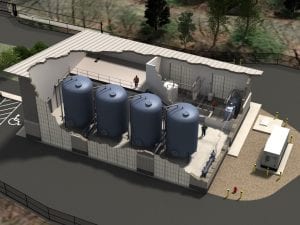
An Artist Rendering of the water Treatment Plant located on Owens District Road (Photo courtesy Westfield Water Dept.)
It is important to note that no source testing above the advisory level was ever introduced into the system. Residents were notified by the city in partnership with the Massachusetts Department of Environmental Protection (DEP) as to the status of the public drinking water supply. The DEP is a regulatory agency that oversees drinking water systems across Massachusetts. All test results are reported to them and they decide if a public notice should be published and the language in such narrative is approved by them. At no time was any information withheld from the people of Westfield.
The carbon filtration solution was studied in depth. Communication with water systems that found themselves in like situations was initiated. Much was learned from these conversations including issues encountered not considered unique to specific entities. As a result, extensive bench scale testing was performed with Westfield water sent to a lab in Washington which specializes in this chemistry. The granular activated carbon was found to remove all trace of the contaminant with no breakthrough. The simulation mirrored months of actual operation in the field. The American Water Works Association (AWWA) recently released a paper concluding that carbon filtration was the most effective and economical method for treatment of this contaminant.
The temporary treatment at well 2 is performing precisely as anticipated and verifies the validity of the bench scale testing and empirical data that supports this course of action. While the system is functioning perfectly it remains a temporary system and is permitted for a finite time by MassDEP.
Permanent treatment plants are under design and construction for both wells 7 & 8 (Owen District Road) and wells 1 & 2 (Dry Bridge Road). The Owen District Road plant is targeted for completion early to mid-summer. The carbon vessels have been installed and building construction is near completion. The Dry Bridge Road plant is approaching 90% design and is anticipated to go out to bid later this calendar year.
The Westfield Department of Public Works continues to aggressively pursue the logical solution to the drinking water issue with its proactive approach proving an industry leader in this endeavor. The Director recently attended the Water Fly-in as part of Water Week in Washington DC where professionals across the country commented on the progress the City of Westfield has achieved. Several other members of the department recently presented at and participated in the annual New England Water Works Expo and were met with like sentiments. There remains one goal and one goal only – to bring clean, safe drinking water to the residents of Westfield. The DPW, Mayor, City Council and other city departments are working collectively toward the optimal solution.

